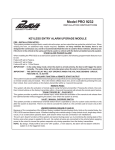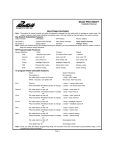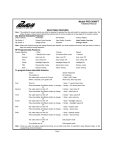Download Directed Electronics S660 User's Manual
Transcript
Model S660 installation guide ProSecurity NOTE: This product is intended for installation by a professional installer only! Any attempt to install this product by any person other than a trained professional may result in severe damage to a vehicle’s electrical system and components. 2 table of contents warning! safety first . . . . . . . . . . . . . . . . . . . . . . . . 4 installation points to remember . . . . . . . . . . . . . . . . 4 before beginning the installation . . . . . . . . . . . . 4 after the installation . . . . . . . . . . . . . . . . . . . . . 4 deciding on component locations . . . . . . . . . . . . . . . 5 locations for the siren . . . . . . . . . . . . . . . . . . . . 5 locations for the control module . . . . . . . . . . . . . 5 locations for stinger doubleguard shock sensor . . . 6 locations for valet/program switch . . . . . . . . . . . 7 locations for the status LED . . . . . . . . . . . . . . . . 7 locations for the optional starter kill relay . . . . . . 8 finding the wires you need . . . . . . . . . . . . . . . . . . . . 8 obtaining constant 12V . . . . . . . . . . . . . . . . . . . 8 finding the 12V switched ignition wire. . . . . . . . . 9 finding the starter wire . . . . . . . . . . . . . . . . . . . 9 finding a (+) parking light wire . . . . . . . . . . . . . 10 finding the door pin switch circuit. . . . . . . . . . . 11 making your wiring connections . . . . . . . . . . . . . . . 12 primary harness (H1), 12-pin connector . . . . . . . . . . 13 auxiliary harness (H2), 6-pin connector . . . . . . . . . . 13 door lock harness, 3-pin connector . . . . . . . . . . . . . 14 ribbon harness, wiring diagram . . . . . . . . . . . . . . . . 14 primary harness (H1) wire connection guide . . . . . . . 15 secondary harness (H2) wire connection guide . . . . . 20 plug-in LED and valet/program switch . . . . . . . . . . . 22 programmer interface, 3-pin black plug . . . . . . . . . . 22 shock sensor harness, 4-pin connector . . . . . . . . . . . 23 programming jumpers . . . . . . . . . . . . . . . . . . . . . . 24 light flash (+)/(-) . . . . . . . . . . . . . . . . . . . . . . 24 transmitter/receiver learn routine™ . . . . . . . . . . . . . 24 transmitter configurations . . . . . . . . . . . . . . . . . . . 26 standard configuration . . . . . . . . . . . . . . . . . . . 26 multi-level security arming . . . . . . . . . . . . . . . . . . . 28 system features learn routine . . . . . . . . . . . . . . . . . 28 feature menus . . . . . . . . . . . . . . . . . . . . . . . . . . . . 30 menu #1 - basic features . . . . . . . . . . . . . . . . . 30 menu #2 - advanced features . . . . . . . . . . . . . . 31 feature descriptions . . . . . . . . . . . . . . . . . . . . . . . . 31 menu #1 - basic features . . . . . . . . . . . . . . . . . 31 menu #2 - advanced features . . . . . . . . . . . . . . 33 nuisance prevention circuitry™ . . . . . . . . . . . . . . . . 35 valet mode . . . . . . . . . . . . . . . . . . . . . . . . . . . . . . 35 table of zones . . . . . . . . . . . . . . . . . . . . . . . . . . . . 36 long term event history . . . . . . . . . . . . . . . . . . . . . 36 troubleshooting . . . . . . . . . . . . . . . . . . . . . . . . . . 37 alarm troubleshooting . . . . . . . . . . . . . . . . . . . 37 wiring quick reference guide . . . . . . . . . . . . . . . . . . 38 3 warning! safety first The following safety warnings must be observed at all times: ■ Due to the complexity of this system, installation of this product must only be performed by an authorized Ungo dealer. installation points to remember before beginning the installation ■ Please read this entire installation guide before beginning the installation. The installation of this remote start system requires interfacing with many of the vehicle’s systems. Many new vehicles use low-voltage or multiplexed systems that can be damaged by low resistance testing devices, such as test lights and logic probes (computer safe test lights). Test all circuits with a high quality digital multi-meter before making connections. ■ Do not disconnect the battery if the vehicle has an anti-theft-coded radio. If equipped with an air bag, avoid disconnecting the battery if possible. Many airbag systems will display a diagnostic code through their warning lights after they lose power. Disconnecting the battery requires this code to be erased, which can require a trip to the dealer. ■ Check with the customer on status LED location. ■ Remove the domelight fuse. This prevents accidentally draining the battery. ■ Roll down a window to avoid being locked out of the car. after the installation ■ Test all functions. The “Using Your System” section of the Owner's Guide is very helpful when testing. ■ When testing, don’t forget that this system is equipped with Nuisance Prevention Circuitry™(NPC™). NPC can bypass trigger zones, making them appear to stop working. See the Nuisance Prevention Circuitry section. ■ Review and complete the Safety Check section of this guide prior to the vehicle reassembly. 4 deciding on component locations locations for the siren Some things to remember about mounting the siren: ■ Keep it away from heat sources, such as radiators, exhaust manifolds, turbochargers, and heat shields. ■ Mount it where a thief cannot easily disconnect it, whether the hood is open or shut. Both the siren and its wires should be difficult to find. This usually involves disguising the wire to look like a factory harness. ■ We recommend against grounding the siren to its mounting screws. Instead, we recommend running both the red and black wires into the passenger compartment and grounding to one common point for all devices. After all, both wires are the same length and come already bonded together. Whenever possible, conceal your wires in the factory harnesses or in the same style loom as the factory. ■ When possible, place the siren on the same side of the vehicle as the control module, where its wires will reach the control module’s wires without extending them. Always run the wires through the center of a grommet, never through bare metal! ■ Point the siren down so water does not collect in it. locations for the control module Some things to remember about where to mount the control module: ■ Never put the control module in the engine compartment! ■ The first step in hot-wiring a vehicle is removing the driver's side under-dash panel to access the starter and ignition wires. If the control module is placed just behind the driver's side dash it can easily be disconnected. ■ When mounting the control module, try to find a secure location that will not require you to extend the harnesses’ wires (they are 1.5 meters long). Keep it away from the heater core (or any other heat sources) and any obvious leaks. 5 ■ The higher the control module is in the vehicle, the better the transmitter range will be. If you put the control module under a seat or inside a metal dashboard, range will diminish. Some good control module locations: above the glove box, inside the center console, above the under-dash fuse box, above the radio, etc. locations for stinger doubleguard shock sensor Some things to remember about where to mount the shock sensor: ■ Never put the Stinger® in the engine compartment! ■ Find a spot close to the control module so that the wires do not need to be extended. Keep it away from the heater core (or any other heat sources) and any obvious leaks. How the Stinger® is mounted is the most important factor in its performance. We recommend two methods: ■ Using double-sided tape or hook-and-loop fastener to mount to a trim panel or an air duct, or ■ Wire-tying to a wire harness. If mounting the sensor where it cannot be easily reached for adjustment, hook-and-loop fastening tape (such as Velcro) is recommended for ease of removal for future adjustments. NOTE: In many vehicles, tying the sensor to a steering column or screwing it to metal will result in poor sensitivity, especially at the rear of the vehicle. 6 locations for valet/program switch IMPORTANT! When the vehicle is delivered, please show the user where this switch is located and how to disarm the system with it. Ensure that the location you pick for the switch has sufficient clearance to the rear. The switch should be well hidden. It should be placed so passengers or stored items (such as in a glove box or center console) cannot accidentally hit it. The switch fits into a 9/32-inch hole. This system has Remote Valet. The user can enter and exit Valet® Mode without having to reach the Valet®/Program switch. This feature was introduced so that switch location was less critical in day-to-day use. As long as the Valet®/Program switch can be reached to disarm without a transmitter, easy access is not important. locations for the status LED Things to remember when positioning the Status LED: ■ It should be visible from both sides and the rear of the vehicle, if possible. ■ It needs at least 1/2-inch clearance to the rear. ■ It is easiest to remove a small panel, such as a switch blank or a dash bezel, before drilling a 9/32-inch hole. ■ Use quick-disconnects near the LED wires if the panel is removable. This lets mechanics or other installers remove the panel without cutting the wires. 7 locations for the optional starter kill relay If optional starter kill relay or its connections are immediately visible upon removal of the under-dash panel, they can easily be bypassed. Always make the relay and its connections difficult to discern from the factory wiring! Exposed yellow butt connectors do not look like factory parts, and will not fool anyone! For this reason, routing the optional starter kill wires away from the steering column is recommended. finding the wires you need Now that you have decided where each component will be located, you’re going to find the wires in the car that the security system will be connected to. IMPORTANT! Do not use a 12V test light or logic probe (computer safe test light) to find these wires! Use a digital multimeter for all testing. obtaining constant 12V We recommend two possible sources for 12V constant: the (+) terminal of the battery, or the constant supply to the ignition switch. Always install a fuse within 12 inches of this connection. If the fuse also will be powering other circuits, such as door locks, a power window module, a Nite-Lite® headlight control system, etc., fuse accordingly. IMPORTANT! Do not remove the fuse holder on the red wire. It ensures that the control module has its own fuse, of the proper value, regardless of how many accessories are added to the main power feed. 8 finding the 12V switched ignition wire The ignition wire is powered when the key is in the run or start position. This is because the ignition wire powers the ignition system (spark plugs, coil) as well as the fuel delivery system (fuel pump, fuel injection computer). Accessory wires lose power when the key is in the start position to make more current available to the starter motor. How to find (+)12V ignition with your multimeter: 1. Set to DCV or DC voltage (12V or 20V is fine). 2. Attach the (-) probe of the meter to chassis ground. 3. Probe the wire you suspect of being the ignition wire. The steering column harness or ignition switch harness is an excellent place to find this wire. 4. Turn the ignition key switch to the run position. If your meter reads (+)12V, go to the next step. If it doesn’t, probe another wire. 5. Now turn the key to the start position. The meter display should stay steady, not dropping by more than a few tenths of a volt. If it drops close to or all the way to zero, go back to Step 3. If it stays steady at (+)12V, you have found an ignition wire. 9 finding a (+) parking light wire The (+) parking light wire is often found near the switch. Many cars have the switch built into the turn signal lever, and in these cars the parking light wire can be found in the steering column. The same wire is often available in the kick panel or running board. NOTE: Many Toyotas, as well as many other Asian vehicles, send a (-) signal from the switch to a relay. The relay then sends (+)12V to the bulbs. Whenever you have difficulty finding a (+) parking light wire near the switch, simply test the wires at any switch or control panel which is lit by the instrument panel lighting. Remember, you need a (+) parking light wire that does not vary with the dimmer setting. How to find a (+) parking light flash wire with your multimeter: 1. Set to DCV or DC voltage (12V or 20V is fine). 2. Attach the (-) probe of the meter to chassis ground. 3. Probe the wire you suspect of being the parking light wire. Usually, the area near the headlight/parking light switch is an excellent area to start, as is the kick panel. 4. Turn on the parking lights. If your meter shows (+)12V, turn off the parking lights and make sure it goes back to zero. 5. If it does return to zero, turn the parking lights back on and, using the dash light dimmer control, turn the brightness of the dash lights up and down. If the meter changes more than a volt when using the dimmer, look for another wire. If it stays relatively close to (+)12V, you have found your parking light wire. 10 finding the door pin switch circuit The best places to find the door switch wire are: ■ At the pin switch: When testing at the pin switch, check the wire to ensure that it “sees” all the doors. Often, the passenger switch will cover all the doors even if the driver’s switch will not. ■ At the dome light: This may not be your best choice if the vehicle has delayed domelight supervision, but it will work in many Hondas, or any vehicle with completely diode-isolated pin switches. Once you have determined the wire color, the easiest place to connect to the wire is often at the kick panel, at the windshield pillar, or in the running board. When an easy location is not available, running a wire to the domelight itself is often the best solution. How to find a door pin switch trigger wire with your multimeter: 1. Set to DCV or DC voltage (12V or 20V is fine). 2. In most Fords, fasten the (-) probe of the meter to chassis ground. In most other cars, fasten the (+) probe of your meter to (+)12V constant. 3. Probe the wire you suspect of being the door trigger wire. If the meter reads (+)12V when any door is opened, you have found a trigger wire. NOTE: Make sure the wire you use “sees” all the doors! Some newer GM vehicles lack standardtype pin switches. The dome light in these vehicles is turned on when the door handle is lifted. These usually have a blue/white or white wire coming out of the door into the kick panel which will provide a (-) trigger for all doors. Some GM vehicles (some Cavaliers, Grand Ams, etc.) have a yellow wire coming out of the door which provides a (+) door trigger. 11 making your wiring connections Before making your connections, plan how your wires will be routed through the vehicle. For instance, the red 12V constant input and the orange ground-when-armed output (for the optional starter kill relay) will often be routed together to the ignition switch harness. In order to keep the wiring neat and make it harder to find, you may wish to wrap these wires together in electrical tape or conceal them in tubing similar to what the manufacturer used. There are two acceptable ways of making a wire connection - solder connections and crimp connectors. When properly performed, either type of connection is reliable and trouble-free. Regardless of whether you solder your connections or you use mechanical-type crimp-on connections, ensure that all connections are mechanically sound and that they are insulated. Cheap electrical tape, especially when poorly applied, is not a reliable insulator. It often falls off in hot weather. Use good-quality electrical tape or heat shrink. ■ Never twist-and-tape the wires together without soldering. ■ Never use “fuse taps”, as they can damage fuse box terminals. If you use tapping connectors such as 3M T-Taps (not to be confused with Scotch-Locks), avoid using them in higher-current applications (constant 12V, ground, etc.). Some tapping connectors are inferior in quality and should be avoided. 12 primary harness (H1), 12-pin connector H1/1 H1/2 H1/3 H1/4 H1/5 H1/6 H1/7 ______ ______ ______ ______ ______ ______ ______ ORANGE WHITE WHITE/BLUE BLACK/WHITE (-) 500 mA ARMED OUTPUT (+)/(-) SELECTABLE LIGHT FLASH OUTPUT NOT USED (-) 200 mA DOMELIGHT SUPERVISION OUTPUT GREEN (-) DOOR TRIGGER INPUT, ZONE 3 BLUE (-) MULTIPLEXED INPUT, ZONE 4 VIOLET (+) DOOR TRIGGER INPUT, ZONE 3 BLACK (-) CHASSIS GROUND INPUT H1/9 ______ EMPTY NOT USED H1/10 ______ BROWN H1/11 ______ RED H1/12 ______ RED/WHITE H1/8 ______ (+) SIREN OUTPUT (+) CONSTANT POWER INPUT (-) 200 mA CHANNEL 2 VALIDITY OUTPUT auxiliary harness (H2), 6-pin connector H2/1 ______ LIGHT GREEN/BLACK (-) FACTORY DISARM H2/2 ______ GRAY/BLACK (-) FACTORY REARM H2/3 ______ H2/4 ______ H2/5 ______ H2/6 ______ GREEN/WHITE (-) PROGRAMMABLE CHANNEL 4 OUTPUT VIOLET/BLACK (-) CHANNEL 5 OUTPUT WHITE/BLACK NOT USED LIGHT BLUE (-) SECOND UNLOCK OUTPUT 13 door lock harness, 3-pin connector 1 ______ 2 ______ 3 ______ GREEN (-) LOCK (+) UNLOCK OUTPUT EMPTY NOT USED BLUE (+) LOCK (-) UNLOCK OUTPUT ribbon harness, wiring diagram 1 ______ 2 ______ 3 ______ 4 ______ 5 ______ 6 ______ 7 YELLOW (+) IGNITION INPUT TO ALARM ______ YELLOW (+) ignition input Connect this wire to the (+) 12 volt ignition wire. This wire is pre-wired to the starter kill relay and must show (+) 12 volts with the key in the RUN position and during cranking. Take care that this wire cannot be shorted to the chassis at any point. 14 primary harness (H1) wire connection guide H1/1 ORANGE (-) ground-when-armed output This wire supplies a (-) ground as long as the system is armed. This output ceases as soon as the system is disarmed. The orange wire is pre-wired to control the starter kill relay. It can supply up to 500mA of current. NOTE: If using the H1/1 Orange wire to activate an add-on accessory such as windo automation, pager or voice module, a 1-amp diode must be installed to ensure proper operation. Insert the diode as shown in the following diagram. IMPORTANT! Never interrupt any wire other than the starter wire. 15 H1/2 WHITE (+/-) selectable light flash output As shipped, this wire should be connected to the (+) parking light wire. If the light flash polarity jumper under the sliding door is moved to the opposite position (see Internal Programming Jumper section of this guide), this wire supplies a (-) 200 mA output. This is suitable for driving (-) light control wires in Toyota, Lexus, BMW, some Mitsubishi, some Mazda, and other model cars. (+) Positive Light Flash Output (-) Light Flash Output NOTE: For parking light circuits that draw 10 amps or more, the internal jumper must be switched to a (-) light flash output. (See the Internal Programming Jumper section of this guide.) P/N 8617 or a standard automotive SPDT relay must be used on the H1/2 light flash output harness wire. 16 H1/4 BLACK/WHITE (-) 200 mA domelight supervision output Connect this wire to the optional domelight supervision relay as shown below: IMPORTANT! This output is only intended to drive a relay. It cannot be connected directly to the domelight circuit, as the output cannot support the current draw of one or more light bulbs. H1/5 GREEN (-) door trigger input, zone 3 Most vehicles use negative door trigger circuits. Connect the green wire to a wire which shows ground when any door is opened. In vehicles with factory delays on the domelight circuit, there is usually a wire that is unaffected by the delay circuitry. This wire will report Zone 3. H1/6 BLUE (-) multiplex input, zone 4 Inputs shorter than 0.8 seconds will trigger the Warn Away response, while inputs longer than 0.8 seconds will trigger the full alarm sequence. If installing an optional Directed Electronics dual stage sensor, connect both the blue and the green wires of the optional sensor to this input. This wire will report Zone 4. 17 H1/7 VIOLET (+) door trigger input, zone 3 This wire is used in vehicles that have a positive (+) switched dome light circuit. Connect the violet wire to a wire that shows (+)12V when any door is opened, and ground when the door is closed. This wire will report Zone 3. H1/8 BLACK (-) chassis ground connection Remove any paint and connect this wire to bare metal, preferably with a factory bolt rather than your own screw. (Screws tend to either strip or loosen with time.) We recommend grounding all your components, including the siren, to the same point in the vehicle. H1/10 BROWN (+) siren output Connect this to the red wire of the siren. Connect the black wire of the siren to (-) chassis ground, preferably at the same point you connected the control module’s black ground wire. 18 H1/11 RED (+)12V constant power input Before connecting this wire, remove the supplied fuse. Connect to the battery positive terminal or the constant 12V supply to the ignition switch. NOTE: Always use a fuse within 12 inches of the point you obtain (+)12V. Do not use the 15A fuse in the harness for this purpose. This fuse protects the module itself. H1/12 RED/WHITE channel 2, 200mA (-) output When the system receives the code controlling Channel 2, for longer than 1.5 seconds, the red/white wire will supply an output as long as the transmission continues. This is often used to operate a trunk/hatch release or other relay-driven function. IMPORTANT! Never use this wire to drive anything but a relay or a low-current input! The transistorized output can only supply 200 mA of current. Connecting directly to a solenoid, motor, or other high-current device will cause it to fail. 19 secondary harness (H2) wire connection guide H2/1 LIGHT GREEN/BLACK (-) factory disarm output This wire sends a negative pulse every time the remote start is activated or the doors are unlocked. This can be used to pulse the disarm wire of the vehicle's factory anti-theft device. Use a relay to send a (-) or (+) pulse to the disarm wire as shown in the following diagrams. Relay for Negative (-) Disarm Wire Relay for Positive (+) Disarm Wire H2/2 GRAY/BLACK factory alarm rearm This wire sends a negative pulse every time the remote start shuts down or the doors are locked. This can be used to pulse the arm wire of the vehicle's factory anti-theft device. Use a relay to send a (-) or (+) pulse to the arm wire. H2/3 GREEN/WHITE 200 mA (-) programmable channel 4 output This wire provides 200 mA programmable output. (See Feature Descriptions section of this guide.) IMPORTANT! Never use this wire to drive anything but a relay or a low-current input! This transistorized output can only supply 200 mA, and connecting directly to a solenoid, motor, or other high-current device will cause the module to fail. H2/4 VIOLET/BLACK channel 5 output This wire provides 200 mA programmable output. (See Feature Descriptions section of this guide.) IMPORTANT! Never use this wire to drive anything but a relay or a low-current input! This transistorized output can only supply 200 mA, and connecting directly to a solenoid, motor, or other high-current device will cause the module to fail. 20 H2/5 WHITE/BLACK (-) diesel wait-to-start bulb input Connect this wire to the wire in the vehicle that sends the signal to turn on the WAIT-TO-START bulb in the dashboard. In most diesels the wire is negative (ground turns on the bulb) and the GRAY/BLACK wire can be directly connected to the wire in the vehicle. If the vehicle uses a positive wire (12V to turn on the bulb) a relay must be used to change the polarity. (See Finding the Wires You Need section of this guide.) Here are some common colors of this wire: ■ Chevrolet and GMC trucks - Light blue or dark blue ■ Ford Trucks - Black/pink ■ Dodge Ram Trucks - Orange/black or black/orange NOTE! A 1-amp diode must be installed in line on the factory wire between the wait-to-start indicator and the ECM. (See the following diagram for details.) H2/6 LIGHT BLUE (-) 200mA 2nd unlock output This wire provides a second unlock output for progressive locks. Refer to document 1041—Door Locking System Wiring Guide for specific applications. 21 plug-in LED and valet/program switch These plug into the module. The Status LED plugs into the small two-pin socket, while the Valet® /Program Switch should be plugged into the larger blue two-pin connector. The Status LED fits into a 9/32-inch hole. Status LED Valet®/Program Switch DIA-41 programmer interface, 3-pin black plug The black 3-pin port is provided for programming of the unit. The unit can also be programmed using the ProSecurity Programmer. When using the ProSecurity Programmer, it is possible to configure any and all of the programmable functions as well as lock the Transmitter/Receiver and System Features Learn Routines so that unauthorized users cannot change the configuration or program transmitters to the unit. When the learn routines have previously been programmed using the ProSecurity Programmer, they may have been locked. Before proceeding with reprogramming the learn routines, they must be unlocked with the ProSecurity Programmer - this cannot be done manually with the Valet switch. 22 shock sensor harness, 4-pin connector GREEN (-) multiplex input, zone 2 Inputs shorter than 0.8 seconds will trigger the Warn Away® response, while inputs longer than 0.8 seconds will trigger full alarm sequence and report Zone Two. If installing an optional Directed Electronics dual stage sensor, connect to the green wire as shown below. The diagram below eliminates the need for diodes to isolate the sensors. Diagram for adding optional Directed Electronics dual stage sensor to green wire (Zone 2): BLUE (-) multiplex input, zone 2 Inputs shorter than 0.8 seconds will trigger the Warn Away® response, while inputs longer than 0.8 seconds will trigger full alarm sequence and will also report Zone Two. RED and BLACK: RED is (+)12V constant, BLACK is (-) ground Do not use these for anything besides the plug-in shock sensor. 23 programming jumpers light flash (+)/(-) This jumper is used to determine the light flash output. In the (+) position, the on-board relay is enabled and the unit will output (+)12V on the WHITE wire, H1/2. In the (-) position, the on-board relay is disabled. The WHITE wire, H1/2, will supply a 200 mA (-) output suitable for driving factory parking light relays. K NOTE: For parking light circuits that draw 10 amps or more, the internal jumper must be switched to a (-) light flash output. P/N 8617 or a standard automotive SPDT relay must be used on the H1/2 light flash output harness wire. transmitter/receiver learn routine™ The system comes with transmitters that have been taught to the receiver. The receiver can store up to 4 different transmitter codes in memory. Use the following learn routine to add transmitters to the system or to change button assignments if desired. The learn routine may be locked if previously programmed using the Bitwriter. If the horn generates one long honk when attempting to program the unit, the learn routine is locked and must be unlocked using the Bitwriter™ before proceeding. 24 The Valet/Program switch, plugged into the blue port, is used for programming. There is a basic sequence of steps to remember whenever programming this unit: Door, Key, Choose, Transmit and Release. 1. Open a door. (The GREEN wire, H1/5, or the VIOLET, H1/7 must be connected.) 2. Key. Turn the ignition to the ON position. 3. Choose. Within 10 seconds, press and release the Program switch the number of times corresponding to the desired channel listed below. Once you have selected the channel, press the switch once more and HOLD it. The LED will flash and the horn will honk (if connected) to confirm the selected channel. Do not release the Program switch. CHANNEL NUMBER FUNCTION WIRE COLOR 1 Auto Learn Standard Configuration** (default) 2 Arm only 3 Disarm only 4 Silent Mode™/Remote Valet®/Trunk Release 5 No function 6 Channel 4 VIOLET/BLACK 7 Channel 5 WHITE/BLACK 8 No function 9 No function 10 Arm/Disarm/Panic 11 Panic only 12 Delete all transmitters RED/WHITE *NOTE: For Auto Learn Configurations, see Transmitter Configurations section of this guide. 4. Transmit. While HOLDING the Valet/Program switch, press the button on the transmitter that you would like to control the selected receiver channel. The unit will chirp to confirm that the code has been successfully programmed. It is not possible to teach a transmitter button to the system more than once. 5. Release. Once the code is learned, the Valet/Program switch can be released. You can advance from programming one channel to another by releasing the Valet/Program switch and tapping it to advance channels and then HOLDING it. For instance: You have programmed Channel 1 and you want to 25 program Channel 2. Release the Valet/Program switch. Press it one time and release it to advance from Channel 1 to Channel 2. Now, press and HOLD the Valet/Program switch. The LED will flash two times and the horn will honk twice (if connected). As before, do not release it. If you want to program Channel 3 after programming Channel 1, release the Valet/Program switch, press it twice and release it to advance to Channel 3. Then press it once more and HOLD it. The horn will honk three times (if connected) and the LED will flash three times to confirm it is ready to receive the code from the transmitter. Learn Routine will be exited if: ■ Door is closed. ■ Ignition is turned off. ■ Program switch is pressed too many times. ■ More than 15 seconds between steps. transmitter configurations The transmitters can be programmed with the standard or single button arm/disarm configurations by using the Auto Learn functions in the Transmitter/Receiver Learn Routine. standard configuration A remote that uses the standard configuration operates similarly to many factory keyless entry remotes. A standard configuration transmitter allows arming, disarming, and Panic Mode activation with separate buttons. When programmed for standard configuration, the transmitter buttons are assigned to the following functions: button configuration .....................................operates ...........................Arm/Lock, Panic ON/Panic OFF ....................................operates ...........................Disarm/Unlock/ panic off .....................................operates ...........................Channel 2—trunk release 26 and .......................operate............................No function and .......................operate............................Channel 4 and ......................operate............................Channel 5 LCD 2-way - only - configuration operates Remote extended functions/LCD backlight and operates Battery Saver Mode and operate Beep/Vibrate Notification and operate Time/Alarm Display The standard configuration for both of the above transmitters also allow the user to utilize Multi-Level Security Arming (described in the following section). 27 multi-level security arming Multi-Level Security Arming is a feature that allows the user to select which of the system's inputs or sensors will be active and which will be bypassed when the system is armed. (See Table of Zones section of this guide.) Multi-Level Security Arming can only be accessed from a standard configuration transmitter. Pressing the arm button of the standard configuration transmitter again within five seconds of arming the system will activate the Multi-Level Security feature. Each time the arm button is pressed again, a different security level is selected. The different levels of security are selected as follows: ■ Pressing one time: The siren chirps once. The system is armed. ■ Pressing a second time within five seconds: The siren chirps twice followed by a long chirp. Zone Two is now bypassed. ■ Pressing a third time within five seconds: The siren chirps three times followed by a long chirp. Zone Four is now bypassed. ■ Pressing a fourth time within five seconds: The siren chirps four times followed by a long chirp. Zones Two and Four are now bypassed. ■ Pressing a fifth time within five seconds: The siren chirps five times followed by a long chirp. All input zones, except the ignition, are now bypassed. system features learn routine The System Features Learn Routine™ dictates how the unit operates. Due to the number of features, the features have been divided into three menus. It is possible to access and change any of the feature settings using the Valet®/Program switch. However, this process can be greatly simplified by using the ProSecurity Programmer. Any of the settings can be changed and then assigned to one of up to four transmitters, a feature called Owner Recognition. Each time that particular transmitter is used to disarm the system, the assigned feature settings will be recalled. Owner Recognition is only possible when programming the unit via the ProSecurity Programmer. The learn routine may be locked if previously programmed using the ProSecurity Programmer. If the horn generates one long honk when attempting to program the unit, the learn routine is locked and must be unlocked using the ProSecurity Programmer before proceeding. 28 To program the features using the Valet switch: 1. Open a door. (The GREEN wire, H1/5, or the VIOLET, H1/7 must be connected.) 2. Key. Turn the ignition on and then back off. 3. Select Menu. Press and HOLD the Valet®/Program switch. When the LED flashes once and the siren chirps, Menu One has been selected. Continue to hold the switch until the LED flashes twice and the siren chirps twice, Menu Two has now been selected. Continue to hold the switch until the LED flashes three times and the siren chirps three times, Menu Three has now been selected. Release the switch after the Menu choice has been selected. 4. Choose. Within 10 seconds, press and release the Valet®/Program switch the number of times corresponding to the feature number you want to program and then press and hold the switch. (See Feature Menus.) After a second, the LED will flash to indicate which feature you have accessed. For example, in Menu Two, groups of eight flashes would indicate access to the activation pulse setting (Feature 2-8). The horn will also honk eight times (if connected). 5. Transmit. The transmitter is used to select the desired setting. Pressing will change the feature to the LED ON setting (or will flash once for features with more than 2 settings). The sire will chirp once (if connected). Pressing will change the setting to the LED OFF setting (or will flash two or more times for features with more than 2 settings). 6. Release. The Valet®/Program switch can now be released. You can advance from feature to feature by pressing and releasing the Valet®/Program switch the number of times necessary to get from the feature you just programmed to the feature you wish to access. For example, in Menu One, if you just programmed Feature 1-2 and you next want to program Feature 1-3 to off, release the Valet/Program switch. Press and release it once to advance from Feature 1-2 to Feature 1-3. Then press it once more and HOLD it. The LED will flash in groups of 3 and the horn will honk 3 times (if connected) to confirm that you have accessed Feature 1-3. 29 The learn routine will be exited if: ■ The door is closed. ■ The ignition is turned on. ■ The Valet/Program switch is pressed too many times. ■ More than 15 seconds elapses between programming steps. One siren wail sound indicates that the Learn Routine has been exited. feature menus The default settings are indicated in bold type. Features that have additional settings that can be programmed using the Bitwriter are indicated with an asterisk (*). menu #1 - basic features FEATURE NUMBER 30 ONE-CHIRP SETTING (DEFAULT) TWO-CHIRP SETTING 1-1 Active arming Passive arming 1-2 Arm/disarm chirps on Arm/disarm chirps off 1-3 Ignition lock ON* Ignition lock OFF* 1-4 Ignition unlock ON Ignition unlock OFF 1-5 Active locking only Passive locking 1-6 Panic with ignition on No panic with ignition on 1-7 0.8 second door lock pulses 3.5 second door lock pulses 1-8 Forced passive arming on Forced passive arming off 1-9 Automatic engine disable on Automatic engine disable off 1-10 Armed When Driving (AWD) on AWD off 1-11 Code Hopping on Code Hopping off menu #2 - advanced features FEATURE NUMBER ONE-CHIRP SETTING (DEFAULT) TWO-CHIRP SETTING 2-1 Siren output constant Siren output pulsed 2-2 30 second siren duration* 60 second siren duration* 2-3 Nuisance Prevention Circuitry on Nuisance Prevention Circuitry OFF 2-4 Progressive door trigger Instant door trigger 2-5 Disarm from Valet, 1 pulse Disarm from Valet, 2-5 pulses 2-6 Door sensor bypass chirp on Door sensor bypass chirp OFF 2-7 Ignition controlled domelight on Ignition controlled domelight OFF 2-8 Single unlock pulse Double unlock pulse 2-9 Factory disarm with Channel Two on Factory disarm with Channel Two OFF 2-10 Channel Four validity Channel Four: latched/latched, reset with ignition/30-sec. timed/60-sec. timed/90-sec. timed 2-11 Channel 5 Validity Channel Five: latched/latched, reset with ignition/30-sec. timed/60-sec. timed/90-sec. timed feature descriptions The features of the system are described below. Features that have additional settings that can be selected only when programming with the ProSecurity Programmer are indicated by the following icon: menu #1 - basic features 1-1 ACTIVE/PASSIVE ARMING: When active arming is selected, the system will only arm when the transmitter is used. When set to passive, the system will arm automatically 30 seconds after the last door is closed. To alert the consumer of passive arming, the siren will chirp 20 seconds after the door is closed. This provides the consumer with an audible warning prior to the system actually arming. At the 30 second mark, the system will arm, but the siren will not chirp. 1-2 CHIRPS ON/OFF: This feature controls the chirps that confirm the arming and disarming of the system. 1-3 IGNITION CONTROLLED DOOR LOCKS ON/OFF: When turned on, the doors will lock three seconds after the ignition is turned on and unlock when the ignition is turned off. There are separate steps for ignition lock and ignition unlock. They can be programmed on or off independently. 31 1-4 IGNITION CONTROLLED UNLOCK: When turned ON the doors will unlock when the ignition is turned OFF. 1-5 ACTIVE/PASSIVE LOCKING: If passive arming is selected in Feature 1-1, then the system can be programmed to either lock the doors when passive arming occurs, or only lock the doors when the system is armed via the transmitter. Active locking means the system will not lock the doors when it passively arms. Passive locking means that the system will lock the doors when it passively arms. NOTE: Remember, when passive arming is selected, the unit will chirp 20 seconds after the last door is closed. The system does not actually arm or lock the doors until 30 seconds after the door has been closed. 1-6 PANIC WITH IGNITION ON: This feature controls whether or not the panic mode is available with the ignition on. In some states, there are laws prohibiting a siren sounding in a moving vehicle. This feature makes the system compliant with these regulations. 1-7 DOOR LOCK PULSE DURATION: Some European vehicles, such as Mercedes-Benz and Audi, require longer lock and unlock pulses to operate the vacuum pump. Programming the system to provide 3.5 second pulses, will accommodate the door lock interface in these vehicles. The default setting is 0.8 second door lock pulses. Some modification to the door lock harness (H2) is also necessary. (See (+/-) Door Lock Outputs Harness (H4) section, "Type E - Mercedes-Benz and Audi -1985 and Newer" diagram.) 1-8 FORCED PASSIVE ARMING ON/OFF: To use this feature, passive arming must be selected in Feature 1-1. When turned on, forced passive arming will ensure that the system will passively arm, even if a zone is left open or invalid. Forced passive arming occurs one hour after the ignition is turned off. 1-9 AUTOMATIC ENGINE DISABLE (AED) ON/OFF: AED is a full-time, passive starter disable that works independently of the security system. When turned on, the orange, ground-when-armed output (H1/1) will activate 30 seconds after the ignition is turned off. The LED will flash at half its normal rate when the ignition is turned off to indicate that AED is active and will interrupt the starter in 30 seconds. AED does not occur in Valet® mode and can be bypassed using the emergency override procedure. The transmitter can be used to disarm AED, however, the system must be armed and then disarmed, using the transmitter, to disarm AED. 1-10 ARMED WHILE DRIVING (AWD) ON/OFF: In the default setting (Armed While Driving), the system can be armed with the ignition on. When armed, the ground-when-armed is not active and the sensors are bypassed. The door triggers will remain active. 1-11 CODE HOPPING™ ON/OFF: The system uses a mathematical formula to change its code each time the transmitter and receiver communicate. This makes the group of bits or "word" from the transmitter very long. The longer the word is, the easier it is to block its transmission to the unit. Disabling the Code Hopping™ feature lets the receiver ignore the Code Hopping™ part of the transmitted word. As a result, the unit may have better range with Code Hopping™ off. 32 menu #2 - advanced features 2-1 SIREN OUTPUT CONSTANT/PULSED: The system can be programmed to output pulses instead of a continuous output when the system is triggered. This is useful to honk the factory horn in applications where a siren is undesirable. Remember that the unit is only capable of supplying 1 amp of current. A relay will be required to interface with most factory horn systems. 2-2 SIREN DURATION 30/60 SECONDS: It is possible to program the unit to sound for 30 or 60 seconds during the triggered sequence. Some states have laws regulating how long a security system can sound. When using the ProSecurity Programmer, the siren can be programmed to sound for any length of time from 1 second to 180 seconds. Use the right and left arrows or the plus (+) and minus (-) keys on the keyboard to change the siren duration in 1 second intervals. Holding down the key will rapidly increase or decrease the setting. 2-3 NUISANCE PREVENTION CIRCUITRY™ (NPC™) ON/OFF: NPC™ stops repeated triggering of the same zone. If one zone is triggered three times in one hour, that zone is bypassed for one hour, starting from the time of the third trigger. During that hour, if the system sees a trigger on that zone again, the system resets the one hour timer. If one hour passes and the zone has not triggered again, the zone is activated and can trigger the system again. NPC™ only monitors sensor inputs, and does not bypass the door trigger or the ignition trigger at any time. If NPC™ is turned off, the system will respond to repeated triggers on the sensor inputs and will do so indefinitely. Some states have laws regulating how many times a security system can trigger before it is considered a nuisance and the vehicle is towed away. 2-4 PROGRESSIVE DOOR TRIGGER ON/OFF: The system responds to a door trigger input with a progressive response. When the door is opened with the system armed, the siren will chirp 10 times prior to the full triggered sequence. The door trigger is still treated as an instant trigger and closing the door quickly will not prevent full triggered sequence from occurring. If the progressive door trigger is programmed off, the full siren output will occur the moment the door is opened. 2-5 VALET PULSE COUNT 1 TO 5 PULSES: The system can be programmed to count the number of presses of the valet switch before disarming the security system. The factory default setting is one pulse. The unit can also be set for two to five pulses. Ghost Switch option: For added security, the GRAY wire on the two-pin Valet®/Program plug can be connected to any switch in the vehicle that provides a negative (-) momentary pulse. 2-6 DOOR SENSOR BYPASS CHIRP ON/OFF: This feature controls the error chirp that is generated if the system is armed with the door trigger active. This is useful in vehicles that have a long dome light delay after the door has been closed. If the system is armed before the dome light has turned off, the security system will generate the door trigger error chirp. If this error chirp is not desired, use this feature to disable the door open error chirp. If the bypass chirp is turned off, no bypass chirp will be generated, even if a door is accidentally left open. 33 2-7 IGNITION CONTROLLED DOME LIGHT SUPERVISION ON/OFF: If turned on, the system will turn on the dome light for 60 seconds when the ignition is turned off. The optional dome light supervision feature must be installed as described in the Wire Connection Guide. 2-8 DOUBLE PULSE UNLOCK ON/OFF: Some vehicles require two pulses on a single wire to unlock the doors. When the double pulse unlock feature is turned on, the BLUE wire will supply two negative pulses instead of a single pulse. At the same time, the GREEN wire will supply two positive pulses instead of a single pulse. This makes it possible to directly interface with double pulse vehicles without any extra parts. 2-9 FACTORY ALARM DISARM WITH CHANNEL 2: In the default setting the factory alarm disarm output will disarm the factory alarm system any time the button(s) controlling Channel Two is pressed. 2-10 CHANNEL 4 VALIDITY/LATCHED/LATCHED RESET WITH IGNITION/30 SECOND TIMED/90 SECOND TIMED OUTPUT: This wire provides a (-) 200mA output whenever the transmitter button(s) controlling Channel 4 is pressed. This output can be programmed to provide the following types of outputs (see also the Feature Menus section): ■ Validity: Output that will send a signal as long as the transmission is received. ■ Latched: Output that will send a signal when the Channel 4 button(s) is pressed and will continue until the same button(s) is pressed again. ■ Latched, reset with ignition: Similar to the latched output, this type of output turns on the first time the Channel 4 button(s) is pressed and turns off the next time the same button is pressed. This type of output additionally stops and resets whenever the ignition is turned on and then off. ■ 30-second timed: Output that will send a continuous signal for 30 seconds. ■ 90-second timed: Output that will send a continuous signal for 90 seconds. 2-11 CHANNEL 5 VALIDITY/LATCHED/LATCHED RESET WITH IGNITION/30 SECOND TIMED/90 SECOND TIMED OUTPUT: Channel Four can be programmed for these output configurations. The unit is set to the default validity output. To change the configuration, use the two-chirp setting to toggle through the different configurations. Refer to channel 4 feature 2-10 for additional detail. 34 nuisance prevention circuitry ™ NPC™ requires that you change the way you test the system as NPC™ will bypass an input zone for 60 minutes. If the system “sees” the same zone trigger three times AND the triggers are spaced less than an hour apart, the system will bypass that input zone for 60 minutes. If that zone does not attempt to trigger the system during the 60-minute bypass period, the zone’s monitoring will begin again at the end of the hour. If it does attempt to trigger while bypassed, the 60-minute bypass starts over again. Disarming and rearming the system does not reset NPC™. The only way to reset NPC™ is for the 60 minutes to pass, without a trigger, or for the ignition to be turned on. This allows the system to be repeatedly triggered, disarmed and rearmed, and still allow NPC™ to bypass a faulty zone. When disarming the system, 5 chirps indicate NPC is activated. The LED will report the zone that has been bypassed. (See Diagnostics section of this guide.) valet mode To enter or exit valet mode with the valet/program switch: 1. Turn the ignition key on and then off. 2. At anytime during the next 10 seconds, press and release the Valet® switch. Now the Status LED will light constantly if you have entered Valet® Mode, and go out if you have exited Valet® Mode. To enter or exit valet mode with the transmitter: To enter or exit Valet® Mode with a transmitter: 1. Open any door. 2. Press 3. Press 4. Press on the transmitter. . again. You have now entered or exited Valet Mode (verify by checking your status LED). 35 table of zones When using the Diagnostic functions, use the Table of Zones to see which input has triggered the system. It is also helpful in deciding which input to use when connecting optional sensors and switches. ZONE NO. TRIGGER TYPE INPUT DESCRIPTION 1 Multiplexed Input BLUE (H1/6) 2 Multiplexed Shock Sensor Input Mux BLUE wire. 3 Door Trigger GREEN (H1/5) and VIOLET (H1/7). 4 Multiplexed Shock Sensor Mux GREEN wire 5 Ignition Yellow ribbon harness wire NOTE: The Warn Away® response does not report on the LED. long term event history The system stores the last two full triggers in memory. These are not erasable. Each time the unit sees a full trigger, the older of the two triggers in memory will be replaced by the new trigger. To access long term event history: 1. With the ignition off, press and HOLD the Valet®/Program switch. 2. Turn on the ignition. 3. Release the Valet®/Program switch. 4. Press and release the Valet®/Program switch within 5 seconds. The LED will flash in groups indicating the last two zones that triggered the unit for one minute or until the ignition is turned off. NOTE: The Warn Away triggers are not stored to memory and will not be reported. 36 troubleshooting alarm troubleshooting ■ Shock sensor doesn't trigger the alarm: Has the NPC™ system been triggered? If so, you will hear 5 chirps when disarming. To check this, turn the ignition key on and off to clear the NPC™'s memory, and then retest the shock sensor. For a detailed description of NPC™, see Nuisance Prevention Circuitry section of this guide. ■ Door input does not immediately trigger full alarm. Instead, chirps are heard for the first 3 seconds: That's how the progressive two-stage door input works! This is a feature of this system. This is an instant trigger, remember, since even if the door is instantly closed again, the progression from chirps to constant siren will continue. ■ Closing the door triggers the system, but opening the door does not: Have you correctly identified the type of door switch system? This happens often when the wrong door input has been used. (See Door Lock Harness Wire Connection Guide section of this guide.) ■ System will not passively arm until it is remotely armed and then disarmed: Are the door inputs connected? Is the H1/6 blue wire connected to the door trigger wire in the vehicle? Either the H1/5 green or the H1/7 violet should be used instead. (See wiring diagrams.) ■ Door input does not respond with the progressive trigger, but with immediate full alarm: Does the Status LED indicate that the trigger was caused by the shock sensor? (See Diagnostics section of this guide.) The shock sensor, if set to extreme sensitivity, may be detecting the door unlatching before the door switch sends its signal. Reducing the sensitivity can solve this problem. ■ The Valet®/Program switch doesn't work. Is it plugged into the correct socket? See Plug-In LED and Valet®/Program Switch section of this guide. ■ Status LED doesn't work. You've probably guessed already, but here goes: Is it plugged in? (See Plug-In LED and Valet®/Program Switch section of this guide.) Is the LED plugged into the correct socket? ■ Door locks operate backwards. This unit has easily-reversed lock/unlock outputs. Recheck wire connections to see if you have reversed these. 37 38 Transceiver Shock sensor port ProSecurity Programmer data port RED/WHITE (-) 200mA channel 2 validity output RED 12V constant input BROWN (+) siren output Empty BLACK (-) ground input VIOLET (+) door trigger input BLUE (-) trunk trigger input GREEN (-) door trigger input BLACK/WHITE (-) 200mA domelight output WHITE/BLUE No function WHITE (+/-) parking light output ORANGE ground when armed output 563/564 Jumper light flash polarity + GREEN (-) lock (+) unlock BLUE (+) unlock (-) lock LIGHT-GREEN/BLACK (-) factory alarm disarm GRAY/BLACK No function GREEN/WHITE (-) factory alarm rearm VIOLET/BLACK (-) 200mA channel 4 output WHITE/BLACK (-) 200mA channel 5 output LIGHT BLUE (-) 2nd unlock output LED Valet/Program button YELLOW (+) ignition input wiring quick reference guide 39 Get Started Get Protected Ungo Pro Security 661 W. Redondo Beach Blvd. Gardena, Ca. 90247 800-GO-CLARION © 2005 Directed Electronics, Inc. - All rights reserved NS660 02-05




























































